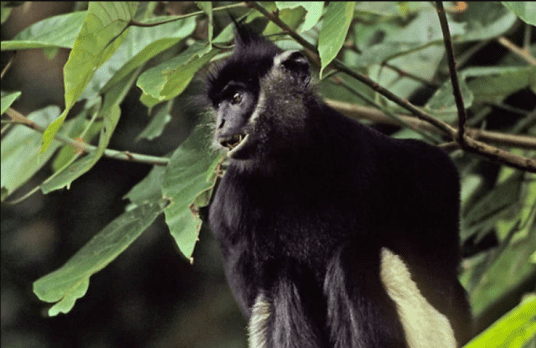Trachypithecus delacouri
IUCN
LCBasic Information
Scientific classification
- name:Trachypithecus delacouri
- Scientific Name:Trachypithecus delacouri,Delacour’s langur,De's black leaf monkey
- Outline:Primates
- Family:Monkey genus
Vital signs
- length:57-62cm
- Weight:6.2-10.5kg
- lifetime:About 20 years
Feature
It is one of the 25 most endangered primates in the world.
Distribution and Habitat
The Delacourt's leaf monkey is only found in Ninh Binh, Ha Nam, Hoa Binh, Thanh Hoa and Ha Tay in northern Vietnam. The largest population of this species lives in the Van Long Nature Reserve.
The Delacourt's leaf monkey lives in small groups in tropical forests and in caves.
Appearance
The male De'er's black leaf monkey is 57-62 cm long, with a tail length of 82-88 cm and a weight of 7.5-10.5 kg; the female De'er's black leaf monkey is 57-59 cm long, with a tail length of 80-86 cm and a weight of 6.2-9.2 kg.
Details
Delacour’s langur (scientific name: Trachypithecus delacouri) is also known as Delacour’s langur, which is named after the leaves it feeds on.

Males reach reproductive maturity in five years, females in four years. Reproduction peaks between January and June each year, with a gestation period of 170 to 200 days, and females usually have one litter per litter. The weaning period is about one year, and the average lifespan is about 20 years.
It is estimated that the number of adult Delacourt's leaf monkeys is less than 250. They live in scattered subgroups, most of which will not survive in the long term, putting the Delacourt's Langur on the brink of extinction. Although legal protections have reduced hunting in recent years, hunting remains the main threat to the Delacourt's Langur's survival. In addition, habitat loss has increased the isolation of existing monkey groups.
The Vietnamese government and some international conservation organizations have made commitments to strengthen the protection of the Delacourt's Langur, greatly improving the survival of this rare species. The main measures include raising the protection level and strengthening law enforcement in the Delacourt's Langur Reserve. The Delacourt's Langur is an endangered species endemic to Vietnam. It is considered one of the 25 most endangered primates in the world. From 2011 to 2013, the German Wildlife Conservation Project released 10 Delacourt's black langurs in Vietnam, aiming to increase the number and quality of Delacourt's black langurs in the Van Long Wetland Reserve. This is a measure to supplement the genetic source of langurs in Vietnam and relevant organizations around the world.
The IUCN Red List is listed as: Critically Endangered (CR).
Protect wildlife and eliminate game.
Maintaining ecological balance is everyone's responsibility!








